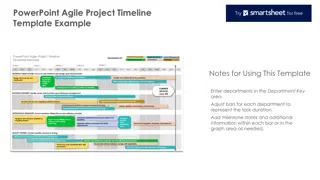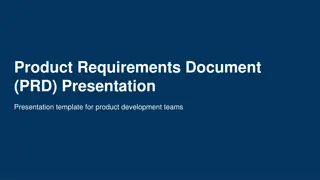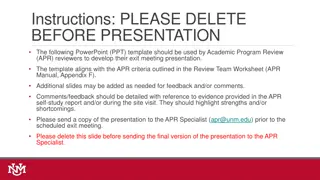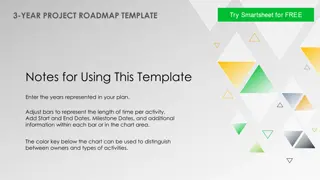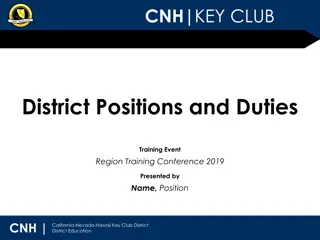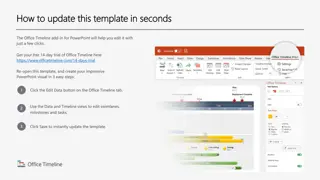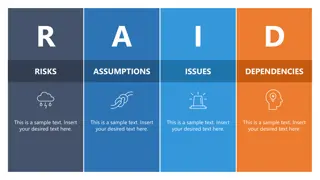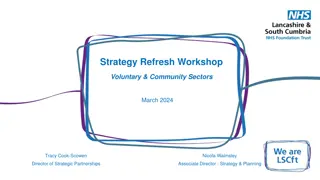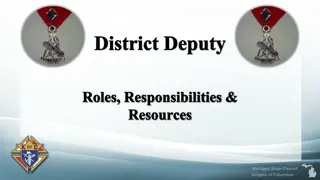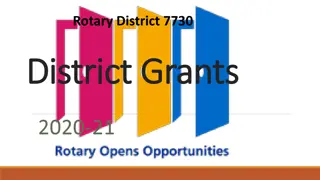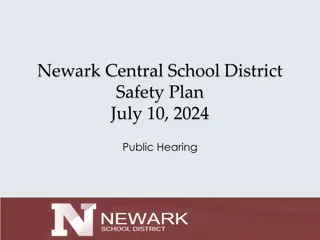District Presentation Refresh Template Overview
This content outlines a comprehensive district presentation refresh template for the School Board in October 2023. It includes objectives, instructions for template use, a 2023 A-F communications timeline, and additional context to enhance communication with stakeholders. The template provides a structured approach for district leaders to customize PowerPoint presentations regarding the A-F accountability system refresh and ratings for the current year.
Download Presentation

Please find below an Image/Link to download the presentation.
The content on the website is provided AS IS for your information and personal use only. It may not be sold, licensed, or shared on other websites without obtaining consent from the author.If you encounter any issues during the download, it is possible that the publisher has removed the file from their server.
You are allowed to download the files provided on this website for personal or commercial use, subject to the condition that they are used lawfully. All files are the property of their respective owners.
The content on the website is provided AS IS for your information and personal use only. It may not be sold, licensed, or shared on other websites without obtaining consent from the author.
E N D
Presentation Transcript
Updated AF Refresh Template District Presentation to School Board October 2023
[Template] Objectives and Instructions Objective Provide an optional editable PowerPoint presentation template for district leaders to customize to use to communicate to School Board members and other stakeholders about this year s ratings and the refresh of the A F accountability system once 2023 ratings are available on Nov. 14. Instructions for Template Use Customize slides 16-17 with 2022 and final What If ratings for two campuses from your district Create copies of slide 16 or 17 to customize for additional campuses as needed Customize slide 21 with 2022 and final What If ratings for your district Customize slides 23-25 with final What If ratings and 2023 ratings for your district and campuses. Create copies of slide 24 or 25 to customize for additional campuses as needed Slide 5 mentions the additional deck to share to provide context on A F purpose, design commitments, and A F refresh changes Many districts have already been communicating about the A F refresh. This resource is intended to supplement existing conversations and resources and can be tailored based on district need.
[Template] 2023 A-F Communications Timeline o May 31:Preliminary What If ratings / communications resources released to districts via TEAL MAY o May 31: EOC performance levels available to districts o June 9:A F Estimator released to districts JUNE o June 20: 2023 Accountability Manual public comment period closes o June 30: EOC results published in Family and Analytic Portals AUGUST o August 11: STAAR 3-8 performance levels available to districts The issuance of A-F ratings under this final rule is pending and subject to change based on judicial rulings or decisions from the 88th Legislature during a special called session. o August 16: STAAR 3-8 assessment results published in Family and Analytic Portals OCTOBER o October 30: Final 2023 Accountability Manual adopted into rule and appendices released o October 30: 2023 A F district communications toolkit (resources for communicating 2023 accountability ratings) o NOVEMBER November 14: 2023 A F ratings released to districts via TEAL o November 16: 2023 A F ratings released publicly (e.g., press release, TXschools.gov) This slide template is designed to be used once 2023 ratings are available STAAR | A-F
[Customize] Additional AF context to share Supplemental A F refresh slides include: Purpose of A F Accountability System A F Design Commitments that Remain Unchanged A F Refresh Changes Supplemental A F Refresh Info can be found on the 2023 Accountability Development webpage.
A-F is a tool to help meet continuously improved goals for students According to state law, the purpose of A-F accountability is: to continuously improve student performance eliminating achievement gaps based on race, ethnicity, and socioeconomic status to ensure this state is a national leader in preparing students for postsecondary success. Improve Student Performance Eliminate Achievement Gaps Prepare Students for Postsecondary Success Fostering a culture that supports growth and continuous improvement when this performance information is public is a difficult but critical task for education leaders.
[Customize] As a district, we have additional information to help us inform performance As a district, we recognize you have additional information outside of the A F accountability system that helps inform performance and continuous improvement. [Placeholder slide] To be replaced with additional performance indicators if determined to be of use during the update presentation.
Extensive feedback has been gathered on potential A-F changes 2019 2020 2021 2022 2023 July 2019 May 2022: Gathered feedback from stakeholders June Nov. Jan. March Multiple rounds of proposed frameworks for the refreshed A-F system were published in the last year, with updates based on feedback
The A-F system has stayed the same during the past 5 years, but statute requires updates to meet goals for students To help school leaders reflect on performance improvements, A-F cut points have remained unchanged since launched in 2017. But A-F indicators must be updated given statutory requirements guiding the goals of the system. 2023 is the year for those changes. A-F Refresh Year
Evaluating performance will be different this year 2022 ratings and 2023 ratings are using different methodologies. SY 2022-23 ratings are based on a different set of rules than previous A-F ratings. 2022 ratings and 2023 ratings cannot be compared side-by-side. The 2023 A-F Refresh methodology shows more differences in campus performance, with a more distributed result. It is possible a campus with an A rating in 2022 may improve in 2023 and yet receive a B rating. It is also possible that a campus with an A rating in 2022 may decline in 2023 and yet maintain an A rating. It s not a simple apples-to-apples comparison this year.
Because of this, TEA is providing districtsWhat If ratings What If ratings use the new A-F methodology from the Final 2023 Accountability Manual in order to view 2022 results under the refreshed framework. What If ratings do not replace 2022 ratings. They are another tool to support continuous improvement moving forward.
TEA is publicly sharing What If ratings with 2023 ratings What If versions of campus and district ratings from 2022, using the new A-F methodology are shared alongside 2023 ratings. This will allow board members, educators, parents and the public to get a sense of whether performance ratings issued in 2023 represent higher, lower, or similar performance as ratings issued in 2022 to support continuous improvement moving forward. AND TXSchools.gov provides an apples-to-apples comparison of ratings under the refreshed cut points & methodology.
What If Ratings Let s get familiar with changes to A-F
[Customize] What If ratings for [campus A - elementary] What If Score (2022 data & 2023 methodology) 2022 Score Changes to methodology No change for elementary and middle schools. High schools and K-12s have increased standards for college, career, and military readiness and graduation rates. Domain 1 Student Achievement [enter] [enter] Domain 2 Student Progress [enter] [enter] No change in methodology. Continues to be best of Domain 2a and 2b. Domain 2a Academic Growth [enter] [enter] Updates methodology to capture growth for more students and includes learning acceleration. Domain 2b Relative Performance No change for elementary and middle schools. High school recalculated given recent improvements in college, career, and military readiness. [enter] [enter] Best of Domain 1 and Domain 2 [enter] [enter] No change in methodology. 70% of overall rating continues to be the best of Domain 1 and 2. Includes more students with a minimum size of 10. Moves from a yes/no to a 0-4 methodology to improve differentiation. Tabulations now focus on just the student groups most in need. Aligned with updated long-term targets. Domain 3 Closing the Gaps [enter] [enter] If a school has <70 in 3 out of the 4 areas (Domain 1, Doman 2a, Domain 2b, Domain 3), the highest overall they can receive is a 69.* Overall [enter] [enter] *This doesn t apply to dropout recovery schools or if Domain 1 is the one area with a score of 70+.
[Customize] What If ratings for [campus B high school] What If Score (2022 data & 2023 methodology) 2022 Score Changes to methodology No change for elementary and middle schools. High schools and K-12s have increased standards for college, career, and military readiness and graduation rates. Domain 1 Student Achievement [enter] [enter] Domain 2 Student Progress [enter] [enter] No change in methodology. Continues to be best of Domain 2a and 2b. Domain 2a Academic Growth [enter] [enter] Updates methodology to capture growth for more students and includes learning acceleration. Domain 2b Relative Performance No change for elementary and middle schools. High school recalculated given recent improvements in college, career, and military readiness. [enter] [enter] Best of Domain 1 and Domain 2 [enter] [enter] No change in methodology. 70% of overall rating continues to be the best of Domain 1 and 2. Includes more students with a minimum size of 10. Moves from a yes/no to a 0-4 methodology to improve differentiation. Tabulations now focus on just the student groups most in need. Aligned with updated long-term targets. Domain 3 Closing the Gaps [enter] [enter] If a school has <70 in 3 out of the 4 areas (Domain 1, Doman 2a, Domain 2b, Domain 3), the highest overall they can receive is a 69.* Overall [enter] [enter] *This doesn t apply to dropout recovery schools or if Domain 1 is the one area with a score of 70+.
New methodology for District Ratings Prior to 2023, district ratings mirrored the K-12/High School campus system. Better of Achievement or Progress: 70% 30% Closing the Gaps School Progress Academic Growth or Relative Performance Student Achievement STAAR 40% CCMR 40% Grad. Rate 20% Academic Achievement - 50% CCMR 30 % Grad. Rate 10% EL Performance 10% K-12/High School System Starting in 2023, district ratings will instead be weighted by enrollment of grade 3-12 students on each campus. The campus weight determines how much a campus grade proportionally impacts the district rating.
Impacts of new methodology for District Ratings Increases alignment of district outcomes with campus outcomes: In 2019, 30% of district ratings were not aligned with their campuses ratings . A district could be A-Rated even when no campus was A- Rated, because of the higher outcomes of one High School. Decreases disproportionate emphasis on high school performance: Specifically, high school CCMR and graduation rates were 60% of Domain 1: Student Achievement scores and an additional 40% of Domain 3: Closing the Gaps scores, making them a significant factor in district ratings that was not reflective of all students within a district.
Example of disproportionate emphasis on HS performance Under the previous methodology, high school performance was over-represented for both Domain 1: Student Achievement and Domain 3: Closing the Gaps. The following illustrates over-representation in Domain 1 for an example high school with 36% of the total district enrollment. For this example, Armadillo HS had a C rating, Big Bend MS received a B , and all 3 elementary schools received an A . Under the old methodology, the district would receive a C rating because of the influence of low CCMR performance and graduation rates at Armadillo HS (which affects 60% of the Domain 1 score). Under the new methodology, the district would receive a B rating because the weight is based on enrollment and Armadillo HS is only 36% of the student enrollment. Domain 1 Weighting Old Methodology 74% 10% 6% 6% 4% (Weighted by Components) New Methodology (Weighted by Enrollment) 36% 26% 15% 14% 9% 100%
[Customize] What If ratings for [district name] * District ratings are now calculated using a weighted average of campus ratings, as opposed to calculating the district as a single K-12 campus. This increases alignment of district ratings with campus ratings. What If Score (2022 data & 2023 methodology) Domain Roll-up from Campuses* 2022 Score Changes to methodology No change for elementary and middle schools. High schools and K-12s have increased standards for college, career, and military readiness and graduation rates. Domain 1 Student Achievement [enter] [enter] Domain 2 Student Progress [enter] [enter] No change in methodology. Continues to be best of Domain 2a and 2b. Domain 2a Academic Growth [enter] [enter] Updates methodology to capture growth for more students and includes learning acceleration. Domain 2b Relative Performance No change for elementary and middle schools. High school recalculated given recent improvements in college, career, and military readiness. [enter] [enter] Best of Domain 1 and Domain 2 [enter] [enter] No change in methodology. 70% of overall rating continues to be the best of Domain 1 and 2. Includes more students with a minimum size of 10. Moves from a yes/no to a 0-4 methodology to improve differentiation. Tabulations now focus on just the student groups most in need. Aligned with updated long-term targets. Domain 3 Closing the Gaps [enter] [enter] If a school has <70 in 3 out of the 4 areas (Domain 1, Doman 2a, Domain 2b, Domain 3), the highest overall they can receive is a 69.* Overall [enter] [enter] *This doesn t apply to dropout recovery schools or if Domain 1 is the one area with a score of 70+.
What If ratings viewed statewide for context All 2021-22 Ratings Stay the Same 2021-22 Ratings Decrease 2021-22 Ratings Increase Campuses Across the state, when viewing What If ratings: Excludes 520 Not Rated Number 5973 1303 1170 Percentage 71% 15% 14% Applying the A-F Refresh methodology to 2021-22 performance causes some campus ratings to go up, some ratings to go down, and some ratings to remain unchanged. 1170 campuses have a higher final What If rating than their actual 2022 final rating. All Campuses - Overall Ratings
What If ratings viewed statewide for context 2021-22 Ratings Stay the Same 2021-22 Ratings Decrease 2021-22 Ratings Increase Campus Type 3565 345 911 Elementary 74% 7% 19% 1416 94 177 Middle 84% 6% 10% 740 709 63 High 49% 47% 4% 252 155 19 K-12 59% 36% 5% Elementary Middle High & K-12
[Customize] 2023 ratings for [district] 2022 What If Score (2022 data & 2023 methodology) 2023 Score Notes Domain 1 Student Achievement [enter] [enter] [Add notes or additional context] Domain 2 Student Progress [enter] [enter] [Add notes or additional context] Domain 2a Academic Growth [enter] [enter] [Add notes or additional context] Domain 2b Relative Performance [enter] [enter] [Add notes or additional context] Best of Domain 1 and Domain 2 [enter] [enter] [Add notes or additional context] Domain 3 Closing the Gaps [enter] [enter] [Add notes or additional context] Overall [enter] [enter] [Add notes or additional context]
2023 AF ratings and 2022 What If Ratings Let s see how we did this year
[Customize] 2023 ratings for [campus A] 2022 What If Score (2022 data & 2023 methodology) 2023 Score Notes Domain 1 Student Achievement [enter] [enter] [Add notes or additional context] Domain 2 Student Progress [enter] [enter] [Add notes or additional context] Domain 2a Academic Growth [enter] [enter] [Add notes or additional context] Domain 2b Relative Performance [enter] [enter] [Add notes or additional context] Best of Domain 1 and Domain 2 [enter] [enter] [Add notes or additional context] Domain 3 Closing the Gaps [enter] [enter] [Add notes or additional context] Overall [enter] [enter] [Add notes or additional context]
[Customize] 2023 ratings for [campus B] 2022 What If Score (2022 data & 2023 methodology) 2023 Score Notes Domain 1 Student Achievement [enter] [enter] [Add notes or additional context] Domain 2 Student Progress [enter] [enter] [Add notes or additional context] Domain 2a Academic Growth [enter] [enter] [Add notes or additional context] Domain 2b Relative Performance [enter] [enter] [Add notes or additional context] Best of Domain 1 and Domain 2 [enter] [enter] [Add notes or additional context] Domain 3 Closing the Gaps [enter] [enter] [Add notes or additional context] Overall [enter] [enter] [Add notes or additional context]
[Customize] 2023 ratings in context [Placeholder slide] If desired, replace this with 2023 ratings of similar or nearby districts or statewide summary information to be shared by TEA when ratings are released.
TEAs communications about 2023 ratings include the use of What If ratings to communicate growth TEA is providing comparisons of 2023 ratings to the What If version of 2022 ratings, rather than actual 2022 ratings: In the TEA Press Release in November In TEA Communications with members of the media On TXschools.gov, TEA shows 2023 ratings alongside 2022 What If ratings Downloadable statewide accountability ratings excel file also includes What If ratings. TXSchools.gov provides an apples-to-apples comparison of ratings under the refreshed cut points & methodology.
TEAs communications about 2023 ratings include the use of What If ratings to communicate growth AND




